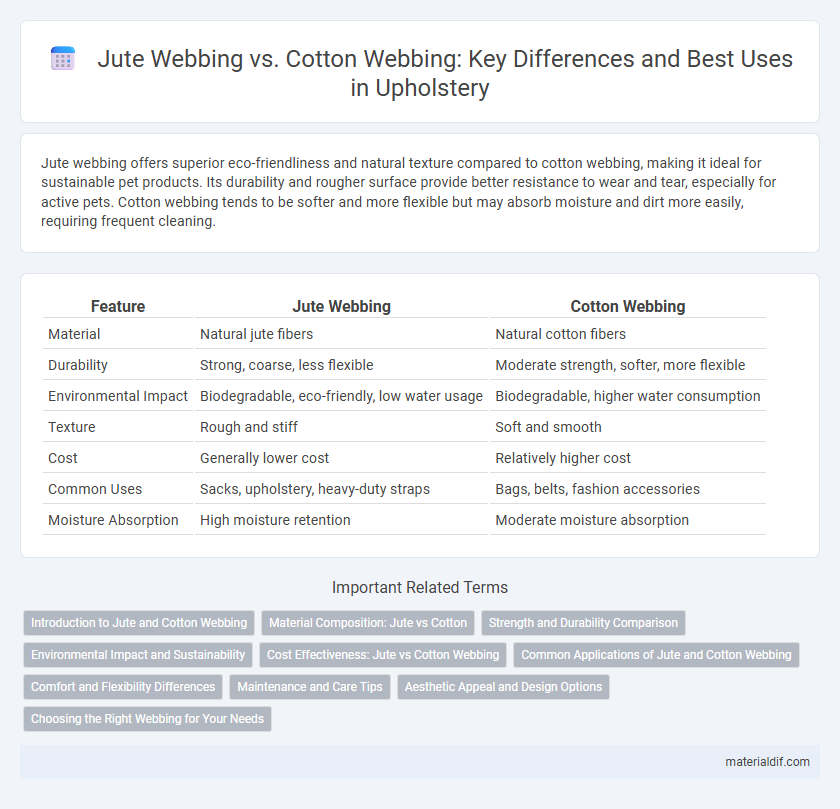Jute webbing offers superior eco-friendliness and natural texture compared to cotton webbing, making it ideal for sustainable pet products. Its durability and rougher surface provide better resistance to wear and tear, especially for active pets. Cotton webbing tends to be softer and more flexible but may absorb moisture and dirt more easily, requiring frequent cleaning.
Table of Comparison
| Feature | Jute Webbing | Cotton Webbing |
|---|---|---|
| Material | Natural jute fibers | Natural cotton fibers |
| Durability | Strong, coarse, less flexible | Moderate strength, softer, more flexible |
| Environmental Impact | Biodegradable, eco-friendly, low water usage | Biodegradable, higher water consumption |
| Texture | Rough and stiff | Soft and smooth |
| Cost | Generally lower cost | Relatively higher cost |
| Common Uses | Sacks, upholstery, heavy-duty straps | Bags, belts, fashion accessories |
| Moisture Absorption | High moisture retention | Moderate moisture absorption |
Introduction to Jute and Cotton Webbing
Jute webbing is a strong, biodegradable natural fiber made from the jute plant, known for its durability and eco-friendly properties, making it ideal for packaging, upholstery, and crafts. Cotton webbing, derived from the soft fibers of the cotton plant, offers flexibility, softness, and high tensile strength, commonly used in apparel, bags, and industrial applications. Both materials serve diverse purposes with jute emphasizing sustainability and cotton highlighting comfort and versatility.
Material Composition: Jute vs Cotton
Jute webbing is made from natural plant fibers derived from the jute plant, offering eco-friendly, biodegradable properties and a coarse texture ideal for heavy-duty applications. Cotton webbing, composed of soft, natural cotton fibers, provides greater flexibility, enhanced comfort, and higher tensile strength suitable for apparel and lighter uses. The material composition difference impacts durability, environmental sustainability, and application versatility between jute and cotton webbing.
Strength and Durability Comparison
Jute webbing offers moderate tensile strength suitable for lightweight applications, whereas cotton webbing provides higher strength and superior durability, making it ideal for heavy-duty use. The natural lignin content in jute fibers contributes to its stiffness but reduces resistance to abrasion and moisture compared to the more flexible and resilient cotton fibers. For applications requiring prolonged wear and exposure to harsh conditions, cotton webbing outperforms jute in longevity and structural integrity.
Environmental Impact and Sustainability
Jute webbing offers superior environmental benefits due to its biodegradability, renewable nature, and low water usage during cultivation, contrasting with cotton webbing which requires significantly higher water and pesticide inputs. The carbon footprint of jute production is considerably lower, making it a more sustainable choice for eco-conscious applications. Compared to cotton, jute webbing decomposes faster in natural conditions, minimizing landfill waste and promoting soil health.
Cost Effectiveness: Jute vs Cotton Webbing
Jute webbing is generally more cost-effective than cotton webbing due to its lower raw material and production costs, making it an economical choice for heavy-duty applications. While cotton webbing offers superior softness and flexibility, jute's durability and lower price point provide substantial savings for bulk purchasing. Industries such as packaging and agriculture benefit from jute webbing's combination of strength and affordability compared to the relatively higher-priced cotton alternatives.
Common Applications of Jute and Cotton Webbing
Jute webbing is widely used in upholstery, bag handles, and eco-friendly packaging due to its natural strength, biodegradability, and rustic appearance. Cotton webbing is commonly applied in apparel accessories, pet collars, and outdoor gear, offering softness, durability, and color versatility. Both materials serve functional and aesthetic purposes, with jute favored for sustainable products and cotton preferred for comfort and flexibility.
Comfort and Flexibility Differences
Jute webbing offers natural breathability and a coarse texture, making it less comfortable for prolonged skin contact compared to the softer, smoother surface of cotton webbing. Cotton webbing provides superior flexibility and softness, which enhances comfort and allows easier movement in applications such as straps and belts. The moisture-wicking properties of cotton also contribute to better comfort under sweaty conditions, whereas jute's rigidity can limit flexibility and cause chafing.
Maintenance and Care Tips
Jute webbing requires gentle cleaning with a mild soap solution and air drying to prevent fiber weakening, while cotton webbing can often withstand machine washing and quicker drying. Avoid prolonged exposure of jute webbing to moisture to reduce the risk of mold and mildew, whereas cotton webbing shows better resilience to repeated washes. Proper storage in a dry, ventilated area is essential for both materials to maintain durability and prevent degradation over time.
Aesthetic Appeal and Design Options
Jute webbing offers a rustic, natural aesthetic with earthy tones and a coarse texture that enhances eco-friendly and vintage designs, making it ideal for artisanal crafts and sustainable products. Cotton webbing provides a smoother finish and greater versatility in dye absorption, allowing for a wider range of vibrant colors and intricate patterns, which suits modern and diverse design applications. Both materials support unique aesthetic preferences, but cotton webbing excels in customizable design options while jute emphasizes organic and textured appeal.
Choosing the Right Webbing for Your Needs
Jute webbing offers natural biodegradability and superior strength, making it ideal for eco-friendly projects and heavy-duty applications such as upholstery and gardening. Cotton webbing provides softness and flexibility, suitable for items requiring comfort and durability like bags and belts. Evaluating the specific requirements of durability, environmental impact, and texture helps determine the optimal choice between jute and cotton webbing for your needs.
Jute Webbing vs Cotton Webbing Infographic

 materialdif.com
materialdif.com